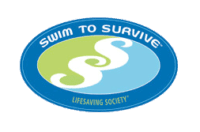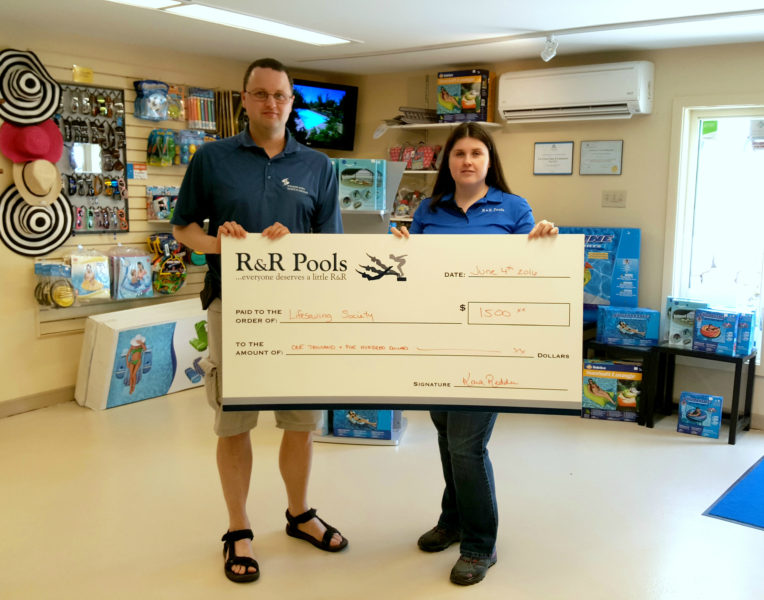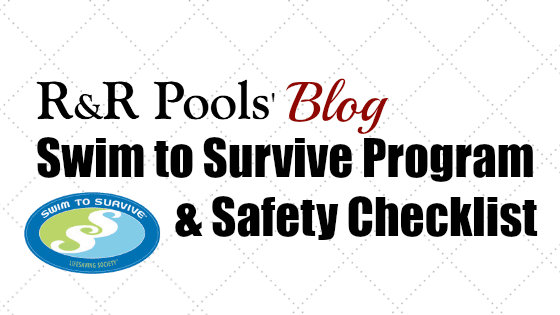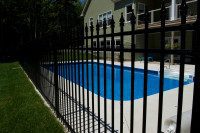With our safety  month nearing an end, I wanted to take a moment to make you aware of the Swim to Survive program (through the Lifesaving Society) which R&R Pools has been a sponsor of for many years now.
month nearing an end, I wanted to take a moment to make you aware of the Swim to Survive program (through the Lifesaving Society) which R&R Pools has been a sponsor of for many years now.
Swim to Survive is a program the Lifesaving Society puts together for Grade 3 students in Nova Scotia, although it is aimed at children, all age groups should be able to perform the society’s Swim to Survive Program.
This program first teaches the children in the classroom: 1. Swim with a buddy 2. Check the ice 3. Wear a life-jacket (PFD). They then have the students bused to various pools throughout the region to teach them: 1. Roll in Deep Water. 2. Tread Water for 1 Minute and 3. Swim 50 meters. This is different than swimming lessons, and not a replacement, it teaches only the essentials needed to survive in an unexpected fall into deep water. Parents are encouraged to enroll their children in swimming lessons as well.
While looking on the website of the Life Saving Society I learned that they estimate ½ of Canadian children never take traditional swimming lessons, even though this is the second most popular activity (for children ages 5- 12) with bicycling being number one. The Lifesaving Society wants to ensure every child has the basic skills to survive.
Their research shows that most drownings occur close to safety. If every child in Canada could pass their Swim to Survive standard, the number of drownings each year would be reduced by half.
Drowning is a leading cause of injury related death for Canadian children and it often happens quickly and silently. If a child is missing, always check the pool first.
Here is a Safety Checklist we developed, which not only talks about the safety of the pool, but safety for the backyard.
Pool Safety:
Gate:
- Ensure the gate is securely fastened
- It is self-closing
- Ability to lock when the pool is not in use.
- Check that all areas of the fence are secure with no access points through or under the fence
- Fence should completely surround the pool, and be difficult to climb.
Signage:
- A sign near the entrance reading “Do not enter without permission”
- A sign displaying the pool rules and water safety rules located near the pool
- A sign stating No Diving (except off a diving board, if there is one available)
- If there is a slide – “Sliding from forward sitting position when sliding, no head first sliding.”
Deck:
- Clean and Obstacle free, no equipment or toys which may cause an accident or trip hazard.
Rescue Equipment
Equipment should include:
- 1 buoyant throwing aid (such as a ring buoy)

- Reaching pole
- Shepherd’s hook
- A sound signalling device such as a whistle
- First aid kit including scissors (in case of entanglement of clothing or hair occurs)
- Telephone with a list of emergency telephone numbers.
- Is the Rescue equipment within reach
Slides and Diving Boards:
- Check diving board surfaces to ensure they are non-slip
- Check diving board and slide to ensure they are secured to the pool deck
- Visible sign reminding everyone that the area in front of diving board / slide to be cleared of others before diving / sliding
Water Tank
- Check buoy lines to ensure they are secured to the sides of the pool and have enough buoys to ensure the line floats at the surface
- The bottom of the pool should be clear from the surface.
- All main drains should be clearly visible from the pool edge.
- Filter water inlets and outlets as well as main drains checked to ensure they are secure and cannot be removed from the pool bottom or sides.
- Water chemistry. Free Available Chlorine should be a minimum of 1 ppm and pH level should be 7.4-7.6.
Sun Protection and Outdoor Safety:
- Avoid distractions when supervising near water
- Don’t rely on water wings or inflatable toys to keep children safe, these are not meant to be life saving devices. There is no substitute for adult supervision.
- Use sunglasses with ultraviolet ray protection
- Always swim with a buddy, no matter what age or how good a swimmer you may be.
- Avoid the sun between the hours of 10:00 a.m. – 3:00 p.m. if at all possible (try to find shade during this time)
- Have plenty of water on hand for drinking. Drink frequently, even when you are not thirsty.
- Use sunscreen
- Reduce consumption of salted foods and drinks

- Reduce the intensity of outdoor activity when temperature levels are higher
- In case of heat stress the following should be done:
- Call for medical assistance.
- Get the person in a shady or air conditioned area
- Cool the person as quickly as you can (even immersing them in water if available)
- Monitor and record body temperature (this will help the medics)
- Have them drink water only (never provide them with alcohol to drink.)
- Make sure food is properly packed in plastic containers
- Chill any meat, milk or perishables




